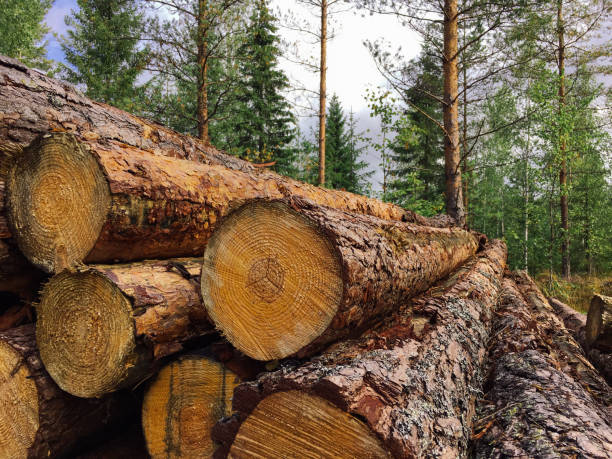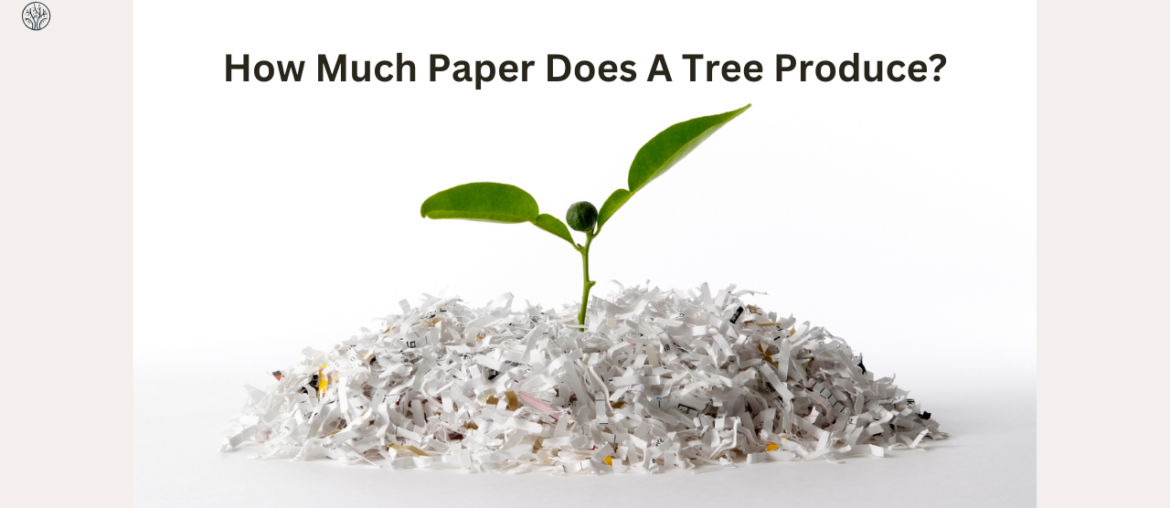Accounting for 13–15% of total global wood consumption, the impact of paper production on global forests cannot be underestimated. The higher the paper consumption, the more trees will be cut down, and vice versa. That means by reducing your paper usage, you can save a lot of trees from being cut down. But how many trees can you save exactly? How much paper does a tree make? Everything will be answered in today’s article.
How Is Paper Made?
Even kids know paper is made of wood, but not everyone knows the exact process of making paper. Basically, the process includes two main steps: making the pulp and drying the pulp.

What is pulp? It’s a soggy suspension of fibers made from trees such as pine, fir, etc. In paper production, there are 3 components of a log that need to be separated to collect the fibers: bark, fiber, and lignin. The bark protects the wood fibers, so we need to remove it from the logs first.
The wood fibers are linked together by lignin, so what we have to do next is separate the lignin from the wood fibers. We can do this by applying either mechanical or chemical techniques
When the fibers are separated from the lignin, we then mix these fibers with water to make them softer. This mixture we call pulp.
Once we have the pulp, spread it out on a wire mesh and allow time for the fibers to knit and bond together. After that, we squeeze out the water from the pulp, dry it, and that’s how you make paper.
Paper can actually be made by hand, and in fact, many high-quality papers are made this way. However, due to great demand, most companies and manufacturers have taken advantage of papermaking machines since the early 1800s. The use of chemicals in papermaking has also become more and more popular due to its efficiency. Chemical pulp paper is generally brighter, smoother, and of higher quality than mechanical ones.
How Much Paper Does a Tree Make, Exactly?
When it comes to the question: “How much paper does a tree make?”, it’s difficult for us to get an exact answer. This is because the paper industry uses many different types of tree species for pulp needs. While pine trees are the primary source for paper production, countless other tree types also contribute to this process. This diversity allows the industry to produce various grades and types of paper for specific purposes.
Plus, the variability of trees themselves is also a challenge in estimating how much paper a tree can make. Trees come in all shapes and sizes, influenced by factors such as age, environment, and species. These differences affect the quantity and quality of pulp that can be harvested from each tree.
The age of the tree is also a factor. Younger trees typically yield less usable pulp than mature ones. Environmental conditions like soil quality and climate also influence a tree’s growth and, consequently, its paper-producing potential.
How Much Paper Does a Tree Make? Average Calculation
As the vast majority of paper is made from pine trees, let’s take pine trees as an example. An average pine tree (50-80 feet tall and 8-10 inches in diameter) can provide approximately 10 cubic feet of wood. According to the general calculation of paper manufacturers, a cord of hardwood (128 cubic feet, equivalent to 13 average pine trees) can provide approximately 1,000-2,000 pounds of paper. That’s about 100-150 pounds of paper per tree.
If it’s hard for you to visualize with this unit of measurement, a pound of paper is equivalent to approximately 100 sheets of paper. That’s 10,000 – 15,000 sheets of paper per tree, and 100,000-200,000 sheets of paper per cord of hardwood.
However, these numbers may vary depending on different materials and techniques, for example, many other types of materials such as bamboo, cotton, hemp, jute, or even china clay can also be added to make certain types of paper.
How Many Trees Are Cut Down For Paper?
As mentioned before, mechanical and chemical pulping are the two primary methods of paper production. In the mechanical pulping process, about 12 trees are sacrificed to yield just one ton of paper. Conversely, the chemical pulping process is more resource-intensive. It requires about 24 trees to produce the same one-ton quantity of paper.
It’s estimated that the total amount of paper used globally is about 400 million tons per year. If nothing changes, this number could reach over 460 million tons by 2031, such an alarming rate.
According to the above numbers, in order to meet the demand for more than 400 million tons of paper each year, we need to cut down nearly 6 to 11 billion trees every year. This number accounts for more than 10% of global deforestation, and it doesn’t seem to be getting any better.
Innovations in Paper Production
There is no way the paper industry is unaware of the deforestation caused by paper production. In fact, the people involved clearly understand the situation, and they’re trying to make the paper industry more sustainable.
Wood manufacturers are especially adopting new techniques and manufacturing processes in order to maximize the amount of paper from the same amount of wood. They began utilizing wood chips or residues from logging, sawmills, or other similar sources to produce individual wood fibers.
Recovered wood fibers are rapidly becoming the go-to material choice of many manufacturers in tandem with virgin fibers. This is due to the increasing environmental awareness of consumers. Virgin wood fibers can be reused 5-7 times before becoming too short to make paper. We can understand this as with the same amount of wood, we can produce many times more paper than originally calculated if we recycle them.
As A Consumer, What Can You Do?
Now that you have the answer to the question “How much paper does a tree make?”, you can see how using too much paper seriously affects the environment. However, as a customer, you can also help offset some of the negative impacts of paper production by prioritizing paper recycling in your daily routine. This way, you can contribute to preserving our planet’s green lungs and mitigating carbon emissions.
Also, you can consider engaging in eco-friendly practices, for example, shopping with Tenere. Each of your purchases will make a huge contribution to global reforestation and forest conservation. Every sheet saved, every tree planted, and every conscious choice you make adds up to a greener, more sustainable future for all.









